Can My Dog Eat Apples: A Complete Safety Guide
Transparency matters to us! This post may include affiliate links, which means we earn a small commission if you make a purchase through our recommendations. This is at no additional cost to you. Read our full affiliate disclosure.
You’re enjoying a crisp apple as an afternoon snack when your dog gives you those irresistible puppy eyes, clearly hoping for a taste. The question “Can my dog eat apples?” crosses your mind as you wonder whether sharing your healthy treat is safe for your furry companion. Apples can indeed be a safe and nutritious treat for dogs when prepared properly, offering valuable vitamins and fiber that support their health. However, certain parts of apples pose serious risks that every dog owner must understand before offering this fruit to their pet. The apple seeds and core contain compounds that can be toxic to dogs, making proper preparation absolutely essential for safety. With the right knowledge about preparation and portion control, apples can become a healthy addition to your dog’s treat rotation that both you and your pet will love.
Key Takeaways
- Apples Are Generally Safe: When properly prepared with seeds and core removed, apples make excellent healthy treats for most dogs
- Seeds and Core Are Toxic: Apple seeds contain cyanide and the core presents choking and blockage hazards that must be avoided
- Nutritional Benefits Are Significant: Apples provide vitamin C, vitamin A, fiber, and antioxidants that support immune health and digestion
- Moderation Is Essential: 1-3 slices per day is safe for most dogs, while excessive consumption can cause digestive upset
- Preparation Matters: Washing, coring, and slicing into appropriate sizes ensures safety and prevents choking
- Special Considerations Apply: Diabetic dogs, puppies, and small breeds require extra caution with portions and preparation
Nutritional Benefits of Apples for Dogs
Apples offer impressive nutritional value that can complement your dog’s regular diet when given as occasional treats. These fruits are packed with essential vitamins, minerals, and antioxidants that support various aspects of canine health. Beyond their nutritional content, apples provide a satisfying crunch that many dogs enjoy, making them an excellent alternative to processed treats. The natural sweetness appeals to most dogs while providing health benefits that processed snacks simply cannot match.
Essential Vitamins and Minerals
Apples contain significant amounts of vitamin A, which supports healthy vision and immune function in dogs. The vitamin C content, while not essential for dogs who produce their own, can provide additional immune system support during times of stress or illness. Potassium found in apples helps maintain proper heart function and muscle health, making this fruit particularly beneficial for active dogs or senior pets with heart concerns.
Fiber Content and Digestive Health
The dietary fiber in apple flesh plays a crucial role in maintaining healthy digestion for dogs. This fiber helps promote regular bowel movements and supports beneficial gut bacteria, contributing to overall digestive wellness. Dogs with occasional constipation may benefit from the gentle fiber boost that properly prepared apples provide. However, too much fiber can cause the opposite problem, which is why moderation remains key when offering apples to your pet.
Antioxidants and Anti-Inflammatory Properties
Apples contain powerful antioxidants that help fight free radicals and reduce inflammation throughout your dog’s body. These compounds may support long-term health by protecting cells from damage and potentially reducing the risk of certain chronic diseases. The anti-inflammatory properties can be particularly beneficial for older dogs dealing with joint issues or other age-related health concerns.
Low-Calorie Treat Benefits
With their low calorie and fat content, apples make excellent treats for overweight dogs or those on restricted diets. Senior dogs who need to maintain a healthy weight can enjoy apple slices without significantly impacting their daily caloric intake. The natural sugars provide energy without the empty calories found in many commercial dog treats, making apples a smart choice for health-conscious pet owners.
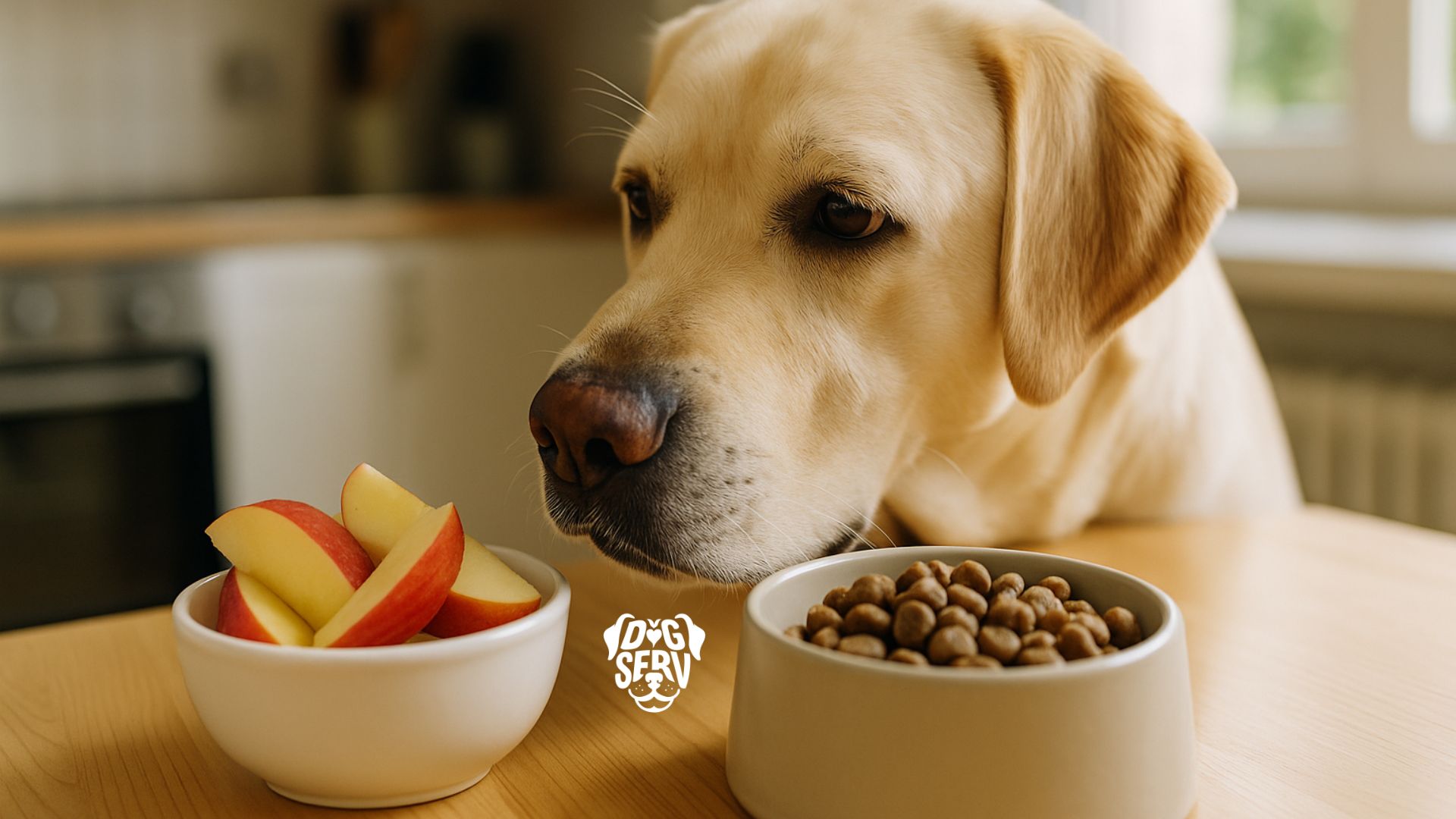
Safety Risks and Toxic Parts
While apples themselves are safe for dogs, certain parts of the fruit pose serious health risks that cannot be ignored. Understanding these dangers is crucial for every dog owner who wants to share apples safely with their pet. The most significant risks come from apple seeds, stems, and cores, which contain toxic compounds and present physical hazards. Even small amounts of these dangerous parts can cause problems, making complete removal absolutely necessary for safe apple consumption.
Apple Seeds and Cyanide Toxicity
Apple seeds contain amygdalin, a compound that releases cyanide when digested, creating a potentially serious toxicity risk for dogs. While a few seeds typically won’t cause immediate harm to larger dogs, the cumulative effect of regular seed consumption can be dangerous. Small dogs face a greater risk from even minimal seed exposure due to their lower body weight. Signs of cyanide poisoning include difficulty breathing, dilated pupils, and bright red gums, requiring immediate veterinary attention.
Core and Stem Hazards
The tough, fibrous apple core presents multiple dangers beyond its seed content. The core can become a choking hazard, particularly for smaller dogs or those who tend to gulp their food quickly. If swallowed whole, apple cores can cause dangerous intestinal blockages that may require surgical removal. The stem poses similar choking and blockage risks while also containing trace amounts of the same toxic compounds found in seeds.
Pesticide and Chemical Concerns
Commercially grown apples often contain pesticide residues and wax coatings that can be harmful to dogs. These chemicals concentrate on the apple’s surface, making thorough washing essential before serving any apple to your pet. Organic apples reduce but don’t eliminate the need for proper cleaning, as they may still carry bacteria or other surface contaminants from handling and transport.
Proper Preparation Methods
Safe apple preparation requires specific steps that eliminate all potential hazards while preserving the fruit’s nutritional benefits. The preparation process may seem straightforward, but attention to detail makes the difference between a healthy treat and a potential emergency. Proper washing, coring, and cutting techniques ensure that your dog receives only the safe, beneficial parts of the apple. Taking time to prepare apples correctly demonstrates the care and responsibility that comes with sharing human food with our canine companions.
Washing and Cleaning Techniques
Begin by thoroughly rinsing the apple under cool running water, using your hands to rub the entire surface. This washing removes pesticides, bacteria, and wax coatings that could harm your dog. For extra safety, consider using a produce brush to scrub away stubborn residues, particularly in the stem and bottom areas where chemicals tend to accumulate. Some pet owners prefer a brief soak in a vinegar-water solution, though thorough rinsing with plain water is generally sufficient for most apples.
Safe Cutting and Portioning
Remove the entire core, including all seeds, stem, and the tough center portion before cutting the apple into appropriate pieces. Use a sharp knife to cut thin slices or small cubes that match your dog’s size and eating habits. Large breed dogs can handle bigger pieces, while small dogs need tiny portions to prevent choking. Always err on the side of caution when determining piece size, as even large dogs can choke on inappropriately sized food.
Peel Considerations
Apple peels contain beneficial fiber and nutrients, but some dogs may have difficulty digesting them. Dogs with sensitive stomachs or digestive issues may benefit from peeled apples to reduce the risk of upset. However, most healthy dogs can handle apple peels without problems, and leaving them on provides additional nutritional value. Monitor your dog’s response to determine whether peeled or unpeeled apples work best for their individual digestive system.

Feeding Guidelines and Portions
Establishing appropriate serving sizes and feeding frequency helps maximize the benefits of apples while preventing digestive problems. Even healthy treats like apples can cause issues when given in excessive amounts, making portion control a critical aspect of safe feeding. The general recommendation of 1-3 slices per day works for most dogs, but individual factors like size, age, and health status may require adjustments. Understanding your dog’s specific needs and monitoring their response to apple treats ensures a positive experience for both pet and owner.
Appropriate Serving Sizes by Dog Size
Small breed dogs weighing under 20 pounds should receive no more than one thin apple slice per day to avoid overwhelming their digestive systems. Medium dogs between 20-50 pounds can safely handle 1-2 slices daily, while large breeds over 50 pounds may enjoy up to 3 slices without problems. These serving sizes assume the apple pieces are cut into manageable portions appropriate for each dog’s mouth size and chewing ability.
Frequency and Timing
Apples work best as occasional treats rather than daily additions to your dog’s diet. Offering apple slices 2-3 times per week allows your dog to enjoy the benefits without risking digestive upset. The timing of apple treats can affect how well your dog tolerates them, with many pets handling fruit better when given between meals rather than immediately after eating their regular food. This spacing helps prevent overfullness and reduces the risk of stomach upset.
Signs of Overconsumption
Watch for symptoms that indicate your dog has eaten too many apples or is having difficulty processing the fruit. Diarrhea, stomach upset, and excessive gas are common signs of apple overconsumption. Some dogs may also experience increased thirst or frequent urination due to the natural sugars and fiber content. If these symptoms occur, discontinue apple treats temporarily and consult your veterinarian if problems persist beyond 24 hours.
Special Dietary Considerations
Certain dogs require modified approaches to apple consumption based on their health status, age, or individual sensitivities. These special circumstances don’t necessarily prohibit apple treats but do require extra caution and potentially veterinary guidance. Dogs with diabetes, puppies, small breeds, and those with digestive sensitivities need individualized approaches to apple feeding. Understanding these specific needs helps ensure that all dogs can potentially enjoy apples safely when appropriate for their particular situation.
Diabetic Dogs and Sugar Content
Diabetic dogs can potentially enjoy small amounts of apple occasionally, but the natural sugars require careful consideration. The fiber content in apples may actually help slow sugar absorption, but the overall carbohydrate content still affects blood glucose levels. Diabetic dogs should only receive apple treats under veterinary supervision, with careful monitoring of blood sugar responses. Many veterinarians recommend avoiding fruit treats entirely for diabetic pets, preferring low-carbohydrate alternatives instead.
Puppies and Small Breed Precautions
Puppies and small breed dogs face increased risks from apple treats due to their size and developing digestive systems. Very small pieces are essential to prevent choking, and even smaller portions help avoid overwhelming their tiny stomachs. Puppies under 12 weeks should generally avoid apple treats until their digestive systems mature further. Small breed dogs may need apple pieces cut into rice-sized portions to ensure safe consumption.
Dogs with Digestive Sensitivities
Some dogs experience digestive upset from high-fiber foods like apples, regardless of proper preparation and portion control. These sensitive dogs may benefit from very small initial portions to test tolerance, or they may need to avoid apple treats altogether. Dogs with known food sensitivities, inflammatory bowel disease, or frequent digestive issues should only try new treats like apples under veterinary guidance. Alternative fruits or vegetables may provide similar nutritional benefits with better tolerance for sensitive stomachs.
Creative Ways to Serve Apples
Beyond simple fresh slices, apples can be prepared in various creative ways that add enrichment and excitement to your dog’s treat routine. These preparation methods can make apple treats more engaging while maintaining all the safety protocols necessary for healthy consumption. Frozen apple treats, homemade recipes, and creative serving methods can enhance the apple experience for dogs. Variety in presentation keeps dogs interested while providing mental stimulation through different textures and temperatures.
Frozen Apple Treats
Freezing prepared apple slices creates refreshing treats perfect for hot weather or teething puppies. Frozen apple cubes can be made by pureeing cored apples with a small amount of water and freezing in ice cube trays. These frozen treats provide extended chewing time and can help soothe sore gums in young dogs. The cold temperature also makes the treats last longer, providing entertainment value beyond simple nutrition.
Homemade Apple Recipes
Dehydrated apple chips make excellent training treats when cut thin and baked at low temperatures until crispy. Remove all cores and seeds before slicing the apples uniformly, then bake at 200°F for 2-3 hours until completely dried. These homemade apple chips provide concentrated apple flavor in a shelf-stable form that’s perfect for training sessions. Store the finished chips in an airtight container and use within one week for best quality and safety.
Apple as Food Topper or Mix-In
Small diced apple pieces can enhance regular meals as a healthy food topper, adding flavor and nutritional variety to routine feeding. This method works particularly well for dogs who are picky eaters or those recovering from illness who need encouragement to eat. The natural sweetness can make regular dog food more appealing while providing beneficial nutrients. Mix small amounts into wet food or sprinkle over dry kibble for variety.
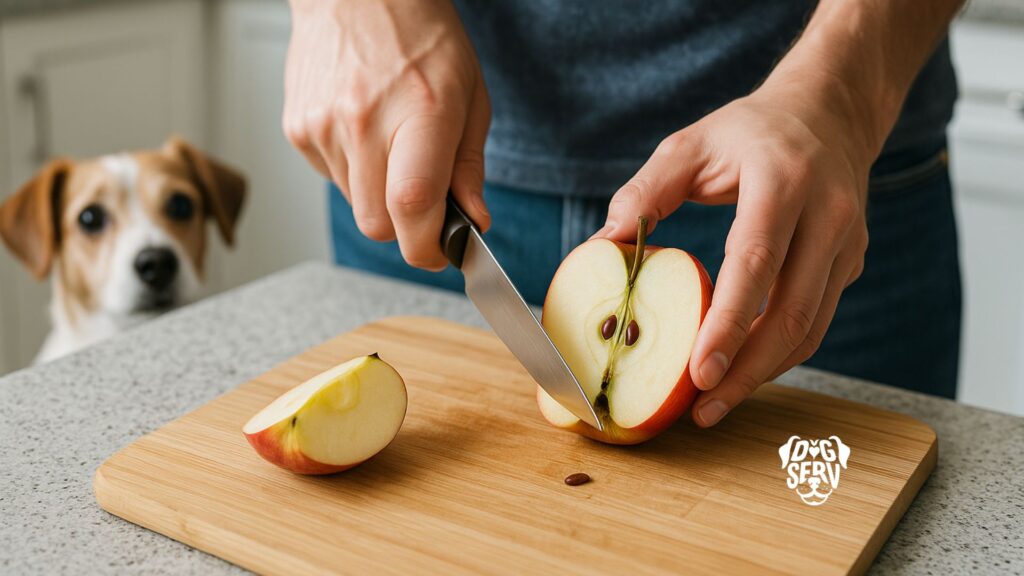
What to Avoid: Dangerous Apple Products
Many apple-containing products that humans enjoy are dangerous or toxic to dogs, despite apples themselves being safe when properly prepared. These products often contain ingredients that are harmful to dogs or are processed in ways that eliminate the benefits while adding risks. Apple pie, caramel apples, and other apple desserts should never be given to dogs due to toxic ingredients and excessive sugar content. Understanding which apple products to avoid helps prevent accidental poisoning and keeps your dog safe.
Apple Pie and Baked Goods
Apple pie and similar baked goods contain nutmeg, excessive sugar, and other spices that are toxic to dogs. Nutmeg can cause hallucinations, increased heart rate, and other serious symptoms in dogs, even in small amounts. The high sugar and fat content in these desserts can trigger pancreatitis, a potentially life-threatening condition. Additionally, the crust and other ingredients provide no nutritional value while adding significant health risks.
Flavored Apple Products
Caramel apples, candy apples, and similar products contain artificial colors, flavors, and preservatives that can be harmful to dogs. The excessive sugar content far exceeds safe levels for canine consumption and can cause immediate digestive upset or long-term health problems. These processed apple products lose all the nutritional benefits of fresh apples while adding dangerous ingredients. The hard candy coatings also present choking hazards and can damage teeth.
Apple Juice and Concentrated Forms
Apple juice contains concentrated sugars without the beneficial fiber found in whole apples, making it unsuitable for dogs. The high sugar concentration can cause digestive upset, contribute to obesity, and potentially trigger diabetes-related complications. Commercial apple juices often contain added sugars, preservatives, and artificial flavors that compound these risks. Even unsweetened apple juice provides too much sugar in a form that’s rapidly absorbed, causing blood sugar spikes.
Safe Fruit Alternatives
When apples aren’t suitable for your dog or you want to provide variety, several other fruits offer similar nutritional benefits with comparable safety profiles when properly prepared. Bananas, blueberries, and cantaloupe are excellent alternatives that many dogs enjoy. These fruits provide different vitamins and minerals while maintaining the low-calorie, high-nutrition profile that makes fruit treats valuable. Like apples, these alternatives require proper preparation and portion control to maintain safety.
Emergency Response
If your dog accidentally consumes apple seeds, core, or dangerous apple products, quick assessment and appropriate response can prevent serious complications. Small amounts of apple seeds typically don’t cause immediate toxicity in larger dogs, but monitoring for symptoms remains important. Signs of concern include difficulty breathing, excessive drooling, vomiting, or changes in gum color. Contact your veterinarian immediately if your dog shows any of these symptoms or if a small dog has consumed any amount of seeds or core material.
For apple core consumption, watch for signs of intestinal blockage, including vomiting, loss of appetite, difficulty defecating, or abdominal pain. These symptoms may not appear immediately but can develop within hours or days of consumption. Large pieces of core material are more likely to cause blockages than small fragments, but any amount warrants careful observation. Keep your veterinarian’s emergency contact information readily available and don’t hesitate to call if you’re concerned about your dog’s condition.
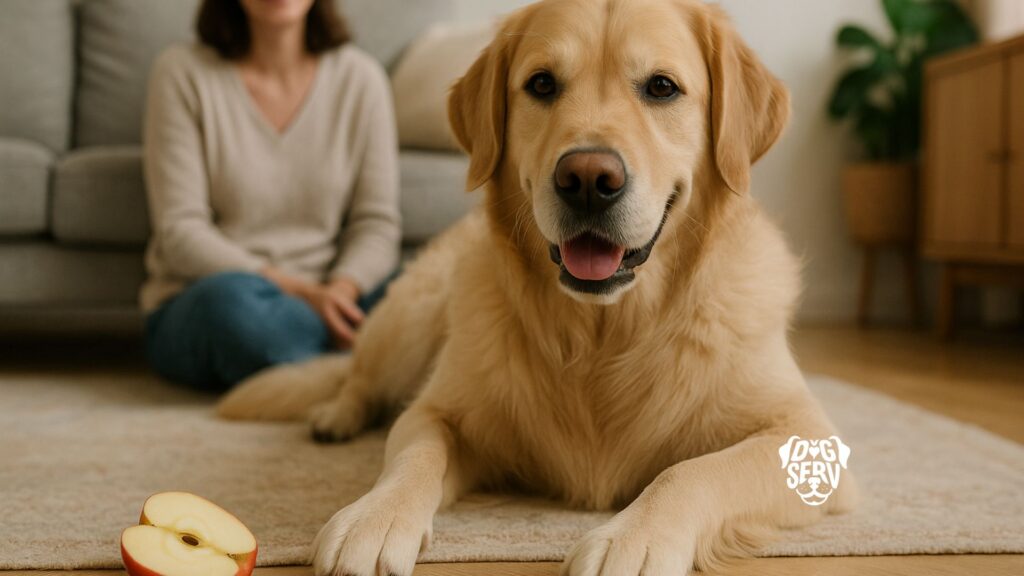
Frequently Asked Questions About Can My Dog Eat Apples
Q: Can dogs eat apple peels?
A: Yes, apple peels are safe and contain beneficial fiber and nutrients, though some dogs with sensitive digestion may need peeled apples to prevent stomach upset.
Q: How many apple slices can I give my dog per day?
A: Generally, 1-3 thin slices per day is safe for most dogs, with smaller portions for small breeds and puppies to prevent digestive issues.
Q: What should I do if my dog ate apple seeds?
A: A few seeds typically aren’t immediately dangerous for larger dogs, but monitor for signs of distress and contact your veterinarian if you notice vomiting, difficulty breathing, or other concerning symptoms.
Q: Can diabetic dogs eat apples?
A: Diabetic dogs may have small amounts of apple occasionally under veterinary supervision, but the natural sugars require careful blood glucose monitoring and professional guidance.
Q: Are green apples safer than red apples for dogs?
A: Both green and red apple varieties are equally safe when properly prepared, as the color doesn’t significantly affect safety or nutritional value for dogs.
Q: Can I give my puppy apples?
A: Yes, but use extra caution with very small portions and tiny pieces to prevent choking hazards, and wait until puppies are at least 12 weeks old before introducing new treats.
Final Thoughts
Apples can be a wonderfully healthy and safe treat for dogs when you take the time to prepare them properly and serve appropriate portions. The key lies in completely removing all seeds and core material while providing only the nutritious flesh in moderation. With proper preparation, apples offer valuable vitamins, fiber, and antioxidants that can support your dog’s health while providing a satisfying, low-calorie snack option.
Remember that every dog is unique, and what works well for one pet may not suit another. Start with small portions to gauge your dog’s tolerance and always monitor for any signs of digestive upset or adverse reactions. When in doubt, consult with your veterinarian about incorporating apples or any new treats into your dog’s diet.
At DogServ, we understand that making the best choices for your furry family member involves having access to reliable, expert-backed information. Our commitment to supporting the entire dog-loving community means providing you with the knowledge and resources needed to keep your pet healthy and happy throughout every stage of their life. Whether you’re looking for nutritional guidance, training support, or premium products for your beloved companion, we’re here to help you give your dog the best life possible.



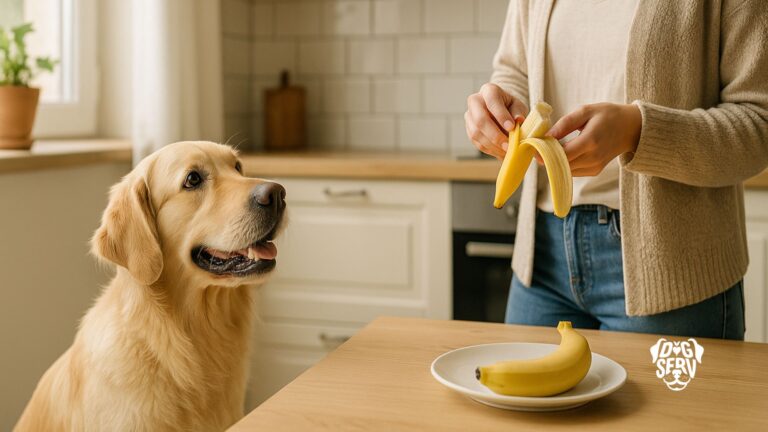
Calvin Hewitt is the primary author and driving force behind DogServ, bringing over 27 years of business expertise and 7 years of specialized digital marketing experience to the dog service industry. As the founder of Web Leveling and architect of DogServ’s evolution from a simple directory to a comprehensive one-stop shop for dog lovers, Calvin has created highly performing dog training websites in competitive markets, developed popular applications like “Can My Dog Eat?” and “Puppy Planning Checklist,” and generated thousands of monthly page views with his dog service content. Based in the Houston area but serving dog lovers and service providers nationally and internationally, Calvin works alongside a dedicated team of seven professionals, combining analytical rigor from his banking and energy industry background with a genuine passion for connecting dog owners, dog lovers, and service providers through quality content, innovative applications, and trusted recommendations.